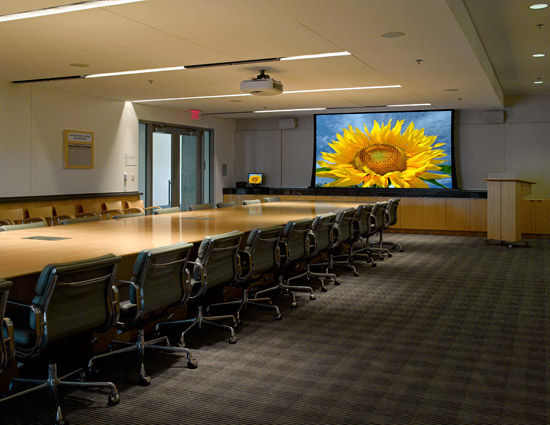Projection Screens Made Simple
To facilitate use of calculators, designers should fully understand the terms touched on previously in this article as well as how to conduct basic measurements. Common input to such models includes the following:
Foot lambert units are used to measure screen image brightness. A quality movie theater will have a screen brightness of 12 to 16 ft. lamberts in a darkened room. A new fresh plasma will have an output of approximately 40 to 45 foot lamberts and is normally viewed with some room lights present.
Lumens are used to measure a projector's peak light output. When screen size is increased, screen gain is reduced, and/or ambient light is present, then projector lumens must be increased to maintain a pleasing screen image.
Foot Candle units are employed to measure the amount of ambient light falling directly on a particular area. Typically, a projection system calculator will take into account ambient light on the screen wall and also ambient light directly over the viewing area. Under most room lighting designs, there will be considerably less ambient light on the screen wall than directly over viewing area. It is important to control the ambient light that is entering the viewer's eye point. Bright lighting over conference tables and work stations reduces the human eye's iris opening which in turn allows less screen light to get to the brain. Calculators will account for the ambient light over the viewing area and will issue an alert when a higher lumen projector is required.
ANSI contrast ratio measures the dynamic range between the peak image brightness and the deepest black level that can be measured on an ANSI black and white checkerboard test pattern. This measurement takes into account the totality of projector output, screen brightness, screen gain and room ambient light reflecting off the screen surface back to the viewer. The ANSI contrast ratio is the single most important number when analyzing a proposed projection system as it is a summary of the performance of the screen image quality. Note: ANSI contrast ratio is not to be confused with projector on-off contrast ratios which are typically stated as 1,000:1 up to 30,000:1.
Measuring ambient light in existing rooms. A basic ambient foot candle light meter should be used to measure ambient light in a room. If a projector is already present, it should be turned off. To measure ambient light on the screen wall, the photo sensor disk should be held so the sensor is facing toward the audience, without the body of the person taking the measurement blocking the ambient light and casting any shadows on the sensor. Note the Foot Candle measurement. The next measurement is to record the ambient light over the viewing area. The photo sensor disk should be held so the sensor is facing toward the screen at the viewers eye level. The foot candle measurement should be noted so that it can be entered into the calculator.
To measure ambient light in rooms that have not yet been constructed, manufacturers recommend employing this type of calculator to determine and specify the maximum Foot Candles of light on the screen wall and in the viewing area when the media is in use.
Using a Typical System Calculator
The latest version of calculators will help to select a material by highlighting the material information in a color and changing the 'recommended' box to a check mark. However, the calculator will only do this if all information necessary has been entered in the fields at the top, and all criteria have been met based upon values that are recommended for those applications. For illustrative purposes, a typical calculator will ask the systems designer to complete the following steps.
• Basic information should be entered into the appropriate fields.
• Image height, width, or diagonal should be entered to calculate overall image size or area.
• Enter the projector's stated lumens to be used. A typical calculator should reduce the manufacturer's published specification by at least 20 percent when calculating to account for lamp degradation and brightness variation when using lenses other than the 'standard' zoom lens. This will also build in some margin of error.
• Enter projector throw distance. Typically, the calculator will tell you if the lens used at that throw distance is compatible with that material and will not create a hot spot.
• Enter the type of application. Some calculators will help to select a material using recommended contrast ratio levels for those applications (i.e., Commercial 15:1 or higher).
• Enter ambient light on screen surface. The calculator will use this value to calculate the ANSI contrast of the image factoring in the ambient light falling on the screen. It will help to select a material that exceeds the value used in the application field.
• Enter ambient light directly over viewer. The measurement will be used to compare directly with the value of foot lamberts that has been calculated for each material. The amount of foot lamberts of brightness on the screen should always be greater than the amount of foot candles of ambient light in the viewing area. The calculator will help select a material that exceeds this by 15 or more to build in some margin of error. If there are not enough foot lamberts, the material will not be selected. The calculator may then register the message 'need brighter projector.'
With the required information, the calculator will help to steer the specifier to materials that work well for an application.
 |
Designers are increasingly using web-based calculators for assistance in selecting the proper projection screen. Photo courtesy of Draper Inc. |
| Checklist for Systems Designers |
|
As a checklist for systems designers, following are the parameters that must be known in order to maximize the viewing experience. What you need to know first:
Screen Selection Process:
During the selection of the screen, it is important to consider the following issues:
|
Basic Projection Screen Information for Maximum Viewing Experiences
Audiovisual communication is here to stay and forms an important part of teaching, training and information dissemination in many fields. In order to ensure that viewers receive the maximum benefit from these presentations, basic projection principles should be understood and applied. For assistance in application, many manufacturers offer calculators that can help in selecting the correct screen format, size, model, viewing surface, and other parameters. With a methodical approach such problem areas as hot spotting and poor readability will be eliminated, and a superior image quality will help viewers see, understand, and retain the information presented.
 |
Draper, Inc., is a Spiceland, Ind.-based manufacturer of projection screens, lifts for projectors and flat panel displays, video conferencing solutions, and window shades. Draper has more than 50 years of experience in the audiovisual industry. www.draperinc.com |








